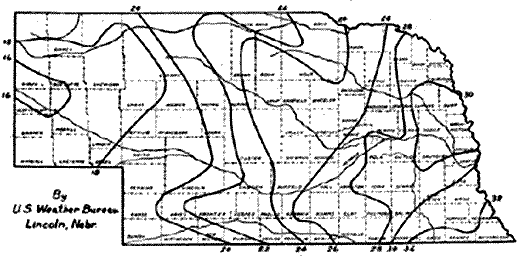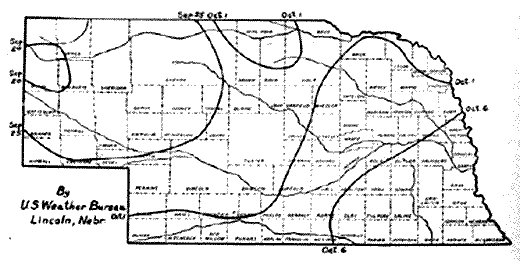|
382 |
NEBRASKA BLUE BOOK, 1926 |
CLIMATE OF NEBRASKA
|
382 |
NEBRASKA BLUE BOOK, 1926 |
CLIMATE OF NEBRASKA
By Thomas A. Blair, U. S. Weather Bureau, Lincoln
The salient features of the climate of Nebraska are briefly presented in the accompanying charts and tables. A long series of daily observations of weather conditions is necessary to ascertain the climate of a place. Weather observations were begun at Fort Kearney in 1849, and since then have been continuous at one or more stations in Nebraska. The number of stations slowly increased to twelve by 1875. In 1878 the Nebraska Weather and Crop Service was organized, and the collection and publication of weather data were placed upon a systematic and permanent basis, with regular reports from numerous volunteer cooperative observers in all parts of the state. Since 1897 this work has been under the direction of the Weather Bureau of the United States Department of Agriculture.
Daily weather records are now made at about 140 stations in Nebraska, all but a. few of them by unpaid cooperative observers, who are thus performing a valuable, even indispensable, public service. It is only by tabulating and summarizing these records that we come to a knowledge of the climate of the state, and it is thus that the following data are obtained.
Table 1 gives the average temperature by months for the various sections and for the state as a whole. There is evident a gradual and fairly uniform decrease in temperature from the southeast to the northwest, showing the combined influence of differences in latitude and in elevation.
Closely connected with the temperature, and itself a climatic element of great importance, is the length of the growing season. This is usually taken as the period between the last killing frost of spring and the first of autumn. The average dates of these events in the different portions of Nebraska are shown in Maps 2 and 3. The average length of the growing season as indicated by these maps increases from 122 days in the northwest to 164 in the southeast. In individual years there is often a wide variation from these averages.
The climatic factor of most general interest because of its direct influence on crop yields is the precipitation. The average annual precipitation in inches of water, as determined from all available records, is shown in Map 1. It ranges from over 32 inches in the southeast to less than 16 inches in a small area in the west.
The precipitation by years and crop seasons for the years, 1850 to 1875, inclusive, is given in Table 2. These values are the best available estimates for this early period, but are not of equal accuracy with the later averages. Since 1876 the stations have been sufficiently numerous and sufficiently well distributed to give reliable averages for the six sections, and the combined section averages give reliable state
|
NEBRASKA BLUE BOOK, 1926 |
383 |
The average snowfall in the state by seasons is given in inches in Table 4. Ten inches of snow will yield on the average about one inch of water. About 12 per cent of the total annual precipitation is in the form of snow.
In Table 5 are summarized for the four first order Weather Bureau stations in Nebraska, the average relative humidity, the average wind velocity and prevailing direction, the amount of sunshine expressed as a percentage of the possible amount, the average cloudiness, and the average number of days on which a measurable amount of precipitation falls. All these are important elements of climate.
TABLE 1.--MEAN TEMPERATURE
|
Months |
State |
N. E. Section |
S. E. Section |
Central Section |
S. W. Section |
W. Section |
N. W. Section |
|
January |
21.9 |
19.8 |
23.4 |
22.1 |
24.8 |
24.2 |
21.2 |
|
February |
25.1 |
22.6 |
26.3 |
24.6 |
27.7 |
26.4 |
23.0 |
|
March |
35.6 |
34.9 |
38.2 |
35.8 |
37.9 |
36.4 |
33.2 |
|
April |
49.0 |
49.7 |
52.0 |
49.5 |
50.6 |
47.0 |
46.1 |
|
May |
59.0 |
59.8 |
61.5 |
59.4 |
60.5 |
56.7 |
66.7 |
|
June |
69.3 |
69.8 |
71.6 |
69.8 |
71.1 |
67.0 |
66.3 |
|
July |
74.6 |
74.8 |
76.7 |
74.9 |
76.4 |
72.7 |
72.2 |
|
August |
72.8 |
72.7 |
74.8 |
73.1 |
74.5 |
71.2 |
70.4 |
|
September |
639 |
64.5 |
66.8 |
64.5 |
65.5 |
62.2 |
61.4 |
|
October |
50:9 |
51.7 |
53.8 |
51.4 |
52.5 |
49.2 |
48.3 |
|
November |
36.7 |
36.8 |
39.6 |
37.2 |
38.7 |
36.6 |
34.9 |
|
December |
25.8 |
24.8 |
28.0 |
26.1 |
27.9 |
27.0 |
25.1 |
|
Year |
48.7 |
48.5 |
61.1 |
49.0 |
50.7 |
48.0 |
46.5 |
|
384 |
NEBRASKA BLUE BOOK, 1926 |
RAINFALL AND FROST MAPS
Based on all available records to 1925, inclusive

MAP 1.- AVERAGE ANNUAL PRECIPITATION IN INCHES

MAP 2.-- AVERAGE DATES OF LAST KILLING FROST IN SPRING

MAP 3.-- AVERAGE DATES OF FIRST KILLING FROST IN AUTUMN
© 2002 for the NEGenWeb Project by Pam Rietsch, Ted & Carole Miller